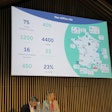At a dedicated session on endometriosis at France's national congress, JFR, on 5 October, delegates heard that the country's national endometriosis diagnosis and management guidelines will be updated and published before the end of the year.
Speaking to AuntMinnieEurope.com from the JFR, Prof. Isabelle Thomassin-Naggara, PhD, who spoke at the session, noted that in a new dedicated protocol for endometriosis imaging, experts have underlined the usefulness of bowel preparation, the necessity to have slices on kidneys and the importance of multiplanar and multicontrast analysis. Furthermore, the use of contrast will not be systematic but reserved mainly for the characterization of atypical endometrioma, the pretreatment evaluation of wall nodules, or in case of nerve injuries.
 Prof. Isabelle Thomassin-Naggara, PhD, from Tenon Hospital, Paris (photo courtesy of Prof. Isabelle Thomassin-Naggara).
Prof. Isabelle Thomassin-Naggara, PhD, from Tenon Hospital, Paris (photo courtesy of Prof. Isabelle Thomassin-Naggara).
One of the most important changes in the updated guidelines will be the implementation of a new validated standardized MR lexicon with specific MR classifications to evaluate the severity of the disease, according to Thomassin-Naggara, head of the Specialized Radiological and Interventional Imaging Service (IRIS) at AP-HP Sorbonne University, Tenon Hospital, Paris.
"A dedicated MR classification is able to help predict operation time, hospital stay, and the risk of postoperative complications. This can help the guidance of patients in referral centers," she noted. "The communication between the radiologist and other specialists and between the radiologist and the patient are crucial issues. Improved communication is based on standardized reports which include drawings and key images."
The European society of Urogenital Radiology (ESUR) has been involved in updating the imaging guidance, with contribution from the Society of Abdominal Imaging (SAR) on the common lexicon project, she added.
The decision to update the guidance came from France's national directorship of healthcare (Direction Générale de l'Offre des Soins, DGOS), which asked the national health authority (Haute Autorité de Santé, HAS) to update the diagnostic imaging section of the "Management of endometriosis" best practice recommendations which were originally drawn up with the National school of gynecologists and obstetricians (Collège National de Gynécologues Obstétriciens CNGOF) and published in 2018.
The update will include the production of good ultrasound and MRI practice guidance sheets to be created in collaboration with the national women's imaging society (Société d'Imagerie de la Femme, SIFEM), the national radiology society (SFR) and the CNGOF.
Medical imaging plays a crucial role in diagnosis, lesion mapping, and therapeutic decisions, particularly in multidisciplinary meetings dedicated to endometriosis, Thomassin-Naggara said. Imaging by lesion mapping enables better definition of the diagnostic and care pathway, and in some cases, referral to centers. With this in mind, the update is to help healthcare professionals manage women suspected of having endometriosis, and to make this management more consistent across the country through the following:
- Improving and standardizing the conditions and procedures for diagnostic imaging examinations
- Standardizing diagnostic imaging reports
- Clarifying imaging strategy: the place of different imaging examinations in the diagnosis of endometriosis.
During the session, five working groups presented the objectives of their work:
- Updating the role of different imaging examinations in the diagnosis of endometriosis.
- Skills for performing endovaginal ultrasound.
- Technical know-how for performing endovaginal ultrasound (including reporting).
- How to perform endometriosis MRI (dedicated protocol).
- How to interpret pelvic MRI for endometriosis (structured reports and proposed classifications) in a diagnostic and preoperative context.
The session highlighted how endometriosis imaging also raises a wide range of political, ethical, societal, financial, and organizational issues that require an integrated approach to improve diagnosis, treatment, and patients' quality of life.
"From a public health perspective, raising awareness of endometriosis is essential to promote early diagnosis and appropriate treatment. Public health policies must support awareness, research, and access to care for people with endometriosis. Meanwhile, at the societal level, raising public awareness can help reduce the stigma associated with the condition and promote greater social support for patients," Thomassin-Naggara said.
She also pointed to financial aspects: insurance reimbursement policies and public health systems must take into account the costs associated with the diagnosis and management of endometriosis to ensure equitable access to care, she noted, adding that this work would enable MRI examination protocols to be standardized, so as to avoid having to repeat the examination in the event of a request for re-reading due to a discrepancy between the patient's symptomatology or the result of a salivary test.
Finally, the organization of care must foster collaboration between different specialties to ensure personalized care for endometriosis patients.
"Radiologists play a key role in combating endometriosis, intervening at all levels. Mastery and in-depth knowledge of diagnostic criteria and imaging modalities are crucial to avoid the risk of overdiagnosis, which has significant psychological and morbid consequences, as well as underdiagnosis, which prolongs diagnostic error," she said.
















